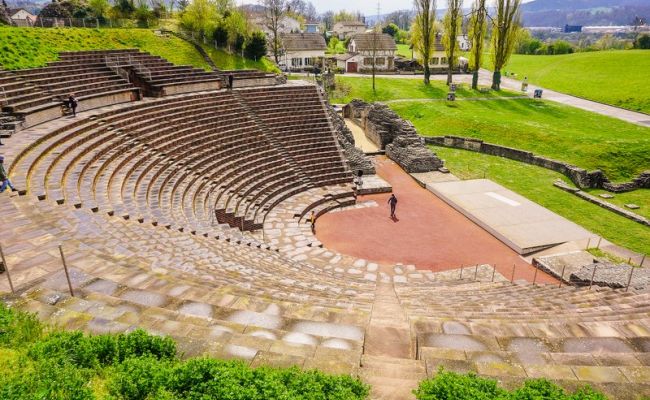Augusta Raurica is an ancient Roman archaeological site near the town of Augst, about 10 kilometers east of Basel in Switzerland. Lucius Munatius Plancus, a Roman general and statesman, founded the settlement around 44 BC and named it after Emperor Augustus and the native Celtic tribe, the Raurici.
History
By the second century AD, Augusta Raurica was a thriving commercial trading center and, at its peak, the seat of a nearby Roman province. Experts estimate the population to be around 20,000 individuals. Augusta Raurica thrived between the first and third centuries, exporting smoked pig and bacon to the rest of the Roman Empire. The city had the standard amenities of a Roman city, including an amphitheater, a main forum, many minor forums, an aqueduct, many temples, multiple public baths, and the largest Roman theater north of the Alps, with 8,000 to 10,000 seats.
Devastation and Relocation
In 250 AD, a huge earthquake devastated much of the city. Shortly thereafter, in 260 AD, Alemanni tribes and/or marauding Roman troops destroyed the city. The Romans attempted to protect their military position by constructing a castle on the Rhine, Castrum Rauracense, whose walls are still partially intact. On a much smaller scale, the Romans relocated Augusta Raurica to the Castrum site. These two localities form the current communities of Augst and Kaiseraugst.
Historical Documentation and Modern Development
The rivers Ergolz and Violenbach. Basel, which became a canton of Switzerland in 1501, received the western section. Basilius Amerbach documented the discoveries of the Roman settlement beginning in 1588, with the assistance of painter Hans Bock. The canton of Basel-Land was incorporated Augst in 1833. The Habsburgs included the eastern section in their territory and renamed it Kaiseraugst to differentiate it from Augst. Kaiseraugst became part of Switzerland in 1803, following the Habsburgs’ defeat in the Napoleonic Wars.
Antiquities
Augusta Raurica is one of the most significant Roman sites in Switzerland. Every day, a team of about 60 people works hard to unlock this cultural treasure, restore and maintain the finds, and make them available to the public.
Multiple ongoing research initiatives conduct excavations, and diverse specialists care for the enormous collection of objects and artifacts. Our staff conducts research and works on restoration and conservation projects following the most recent internationally approved norms. An important aspect of the job is networking and partnering with a variety of other institutions and universities. Lastly, Augusta Raurica operates its own publishing house to ensure the publication of ongoing research.
Augusta Raurica is more than just a tourist destination.
All visitors above the age of 12 must wear masks in the museum, including the Roman House, as well as during all guided tours and seminars.
FAQ
Who were the Romans?
The Romans consisted of men, women, and children. They lived 2,000 years ago.
In certain localities in Switzerland. These locations included the town of Augusta Raurica. This is why we named our museum Augusta Raurica.
What does Augusta Raurica mean?
Augusta Raurica is a town named after the Roman emperor Caesar Augustus, indicating its link to his administration. It is located in an area where the Raurici, an indigenous people, lived before the arrival of the Romans. This historical site symbolizes the merging of Roman government with pre-existing local settlements, providing insights into ancient cultural and territorial dynamics.
